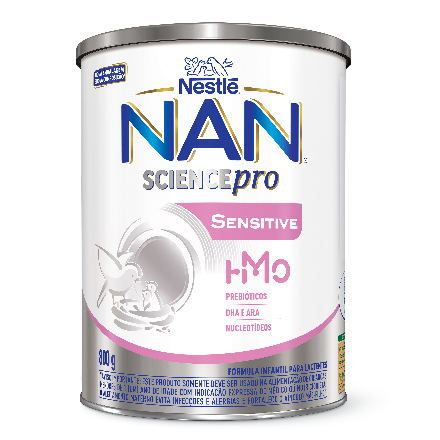NAN SCIENCEPRO Sensitive® HMO

Sobre
Fórmula Infantil para lactentes.
Contém:
- DHA e ARA
- Prebióticos
- Nucleotídeos
As informações deste conteúdo estão destinadas apenas a profissionais da saúde
Se você é um profissional da saúde, faça login ou cadastre-se para acessar o conteúdo.
| Por 100 g de pó | Por 100 ml de fórmula reconstituída | |
|---|---|---|
| Valor energético (kcal) | 500 kcal = 2100 kj | 67 kcal = 281 kj |
| Carboidratos, dos quais: | 57 g | 7,6 g |
| Lactose | 43 g | 5,8 g |
| Amido | 14 g | 1,9 g |
| Proteínas | 9,5 g | 1,3 g |
| Gorduras totais | 26 g | 3,5 g |
| Gorduras saturadas | 6,2 g | 0,8 g |
| Ácido linoleico | 4,0 g | 0,5 g |
| Ácido α-linolênico | 330 mg | 44 mg |
| Ácido docosahexaenóico (DHA) | 60 mg | 8,0 mg |
| Ácido araquidônico (ARA) | 60 mg | 8,0 mg |
| Gorduras trans | 0 g | 0 g |
| Fibra alimentar | 3,0 g | 0,4 g |
| Fruto-oligossacarídeo (FOS) | 0,3 g | 0,04 g |
| Galacto-oligossacarídeo (GOS) | 2,7 g | 0,36 g |
| Sódio | 195 mg | 26 mg |
| Cálcio | 350 mg | 47 mg |
| Ferro | 5,5 mg | 0,74 mg |
| Potássio | 565 mg | 76 mg |
| Cloreto | 370 mg | 50 mg |
| Fósforo | 190 mg | 25 mg |
| Magnésio | 46 mg | 6,2 mg |
| Iodo | 179 μg | 24 μg |
| Cobre | 450 μg | 60 μg |
| Zinco | 5,1 mg | 0,68 mg |
| Selênio | 18 μg | 2,4 μg |
| Manganês | 100 μg | 13 μg |
| Vitamina A | 650 μg RE | 87 μg RE |
| Vitamina D | 6,8 μg | 0,91 μg |
| Vitamina E | 11 mg a-TE | 1,5 mg a-TE |
| Vitamina K | 39 μg | 5,3 μg |
| Vitamina C | 110 mg | 15 mg |
| Vitamina B1 | 0,50 mg | 0,07 mg |
| Vitamina B2 | 1,2 mg | 0,16 mg |
| Niacina | 5,8 mg | 0,77 mg |
| Vitamina B6 | 0,36 mg | 0,05 mg |
| Ácido fólico | 80 μg | 11 μg |
| Ácido pantotênico | 4,8 mg | 0,64 mg |
| Vitamina B12 | 1,3 μg | 0,17 μg |
| Biotina | 34 μg | 4,6 μg |
| Colina | 52 mg | 7,0 mg |
| Inositol | 34 mg | 4,6 mg |
| Taurina | 29 mg | 3,9 mg |
| L-carnitina | 9,6 mg | 1,3 mg |
| Nucleotídeos | 15 mg | 2,0 mg |
Reconstituição com 13,4 g de pó e 90 ml de água = 100ml.
Capacidade da colher medida: 4,47 g. *FOS e GOS são prebióticos.
- Iacono G et al. Dig Liver Dis 2005; 37: 432-8.
- Jung C et al. International Journal of Child Health and Nutrition, 2017; 6: 62-69.
- Raiha H et al. Child:Care,Health Development. 2002. 28,5,419–429
- Billeaud C et al. Eur J Clin Nutr. 1990;44:577-83.
- Vandenplas Y et al. Acta Paediatr. 2014 Jul;103(7):689-95.
- Exl B et al. Eur J Nutr 39 : 145–156 (2000).
- Arikan D et al. Journal of Clinical Nursing. 2008. 17, 1754–1761
- Kanabar D et al. J Hum Nutr Dietet. 2001. 14: 359- 363
- Vivatvakin B et al. Asia Pac J Clin Nutr 2010;19 (4):473-480.
- Costalos C et al. Early Human Development (2008) 84, 45–49.
- Czerkies LA et al. Int J Pediatr. 2018 Nov 1;2018:4969576.
- Horvath A et al. Pediatrics 2008. 122, 6.
- Sociedade Brasileira de Pediatria. Departamento Científico de Nutrologia, 4ª. ed. São Paulo, 2018.
- Bode L. Glycobiology. 2012 Sep;22(9):1147-62.
- M Tonon K et al. Nutrients. 2019 Jun 17;11(6):1358.